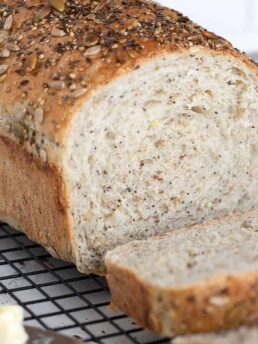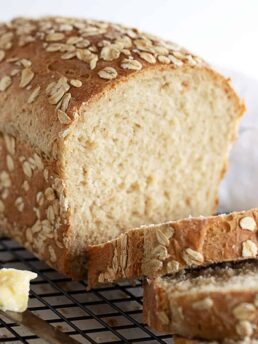Types of Yeast and Which One To Use When
When it comes to yeast, there are 6 basic types of yeast …
- Active Dry (Traditional) Yeast
- Instant Yeast
- Bread Machine/Pizza Yeast
- Rapid Rise (or Quick Rising) Instant Yeast
- Fresh Yeast
- Compressed Yeast Cubes
Let’s explore each type and the differences …
Active Dry (Traditional) Yeast
Active Dry Yeast is the original type of yeast that your mother or grandmother would have used, as well. Active Dry Yeast MUST BE ACTIVATED IN WARM WATER. This process of activating in water is called “proofing” the yeast. The water to active dry active yeast should be about 110F. Using water that is too hot can kill the yeast. Using water that is too cool can lead to a very long rising period.
Active dry yeast is a two-rise yeast, meaning that you mix the dough and let it double, before shaping. After shaping, you will need a second rising period, before baking. It also tolerates cold-proofing well.
The down-side of Active Dry Yeast is that it is well known to be unstable and somewhat unreliable. It has a fairly short shelf like, it’s potency declines over time and it can sometimes fail without apparent reason.
Instant Yeast
Instant yeast is nothing more than active dry yeast, without the protective coating. The lack of protective coating means that Instant Yeast doesn’t need to be activated by water. It can be added directly to the dry ingredients, which is very convenient!
That said, while you don’t need to proof Instant Yeast in water, you can certainly do so, if you like. This makes it easy when following a recipe written for Active Dry yeast and just following along with the water proofing instructions, instead of having to make any adaptations.
It’s worth noting that Instant Yeast can tolerate a warmer proofing water than Active Dry Yeast, tolerating a temperature up to about 130F.
Instant Yeast is a two-rise yeast, similar to the performance of Active Dry Yeast and also tolerates cold-proofing well. It also has a long shelf life and if kept in the freezer, will stay good for up to two years!
Bread Machine/Pizza Yeast
Bread Machine Yeast or Pizza Yeast is essentially Instant Yeast, just with some slight additives to best suit the use (bread machine or pizza making). While best use for its intended purpose, it will perform similarly to Instant Yeast. Long and slow or cold-proofed doughs might perform less well with Bread Machine Yeast as opposed to Instant Yeast.
Bread Machine Yeast is, of course, intended to be added directly to dry ingredients, which is how bread machines work. Bread Machine Yeast also keeps well.
Fast Rising or Quick Rising Instant Yeast
Fast Rising or Quick Rising Yeast is Instant Yeast that has been coated with yeast enhancers that offer up quick and enthusiastic activation right out of the gate. This is yeast for the impatient and is best used for shorter, typical one or two-rise yeast bakes.
The down-side of Rapid Rise Yeast is that it is unsuitable for doughs with a long, slow rise or for cold-proofing. These limitations mean that Quick Rise Yeast should never be the only yeast in your kitchen, but it does have its place.
Important! Always refer to the instructions on the yeast container when using fast, quick or rapid rise yeast. Some types of yeast will suggest shaping right after mixing, while others might suggest doing a short 10-minute resting period after mixing and before shaping, instead of a standard first rise until doubled. If so, follow the directions on the package and not in the recipe.
Quick Rise Yeast might seem like a great choice for it’s time-saving qualities, but, when it comes to yeast baking, time = flavour, so while you shorten the rising time, you may sacrifice a bit in terms of depth of flavour. Typical yeast breads, in particular, benefit from the traditional two-rises for best flavour. Rapid rise yeast is best suited for sweet rolls or quick dinner rolls etc.
Quick Rise Yeast should be added directly to dry ingredients and not proofed in water, similar to regular Instant Yeast. Rapid Rise Yeast also has a long shelf life and is quite reliable.
It’s worth noting that in a pinch, if Quick Rise Yeast is your only option that proofing it in water will effectively remove the coating that results in the “quick” part :) So the soaking will, in effect, turn Quick Rise Yeast back into regular Instant Yeast and that will allow you to proceed with the traditional two rises of conventional bread making. Again, this is “in a pinch” :) It is always better to use the right yeast for your baking project.
Fresh Yeast aka Compressed Yeast
Fresh Yeast is a type of yeast widely used by baking professionals, but largely unavailable easily to the average consumer in North America. It is more often seen in Europe, where it can be found in the refrigerated section of grocery stores. Fresh yeast does not keep well. It will last only about two weeks in the refrigerator.
Compressed yeast and dry yeast can be used interchangeably in baking. Once “cake” of compressed yeast is equal to one “packet” or 2 1/4 teaspoons of Active Dry yeast or you can use the following conversion – 1/4 oz/2 1/4 tsp/7 grams of Dry Active Yeast is equal to 2/3 oz/19 grams of Fresh Compressed Yeast.
Compressed yeast can be softened in water or added directly to dry ingredients.
Summary: Which Yeast to Use When
- When to use Active Dry Yeast: I say pretty much never :) Given the disadvantages of Active Dry Yeast, there is really no reason to chose it over Instant Yeast, which performs equally well, without the downsides. Active Dry Yeast is rarely used in professional baking settings, so why be saddled with it in our kitchens.
- When to use Instant Yeast: Pretty much all the time! Instant Yeast is the best all-round yeast to keep in your kitchen. It’s effective, stable, has a long shelf life (especially when frozen) and it’s easy to use, since it doesn’t need proofing in water. Simply throw it in with the flour! Instant Yeast is the yeast of choice for professional bakers, so that is about the best recommendation we need.
I use Instant yeast for about 95% of the time. I love SAF Brand Yeast (red package). You can easily order SAF yeast on Amazon. It comes in a large, vacuum-packed package, that I empty into a freezer container and store in the freezer. I use it directly from the freezer. It will keep in the freezer a long time (up to 2 years!), so I don’t worry about not using it up.
- When to use Rapid Rise Instant Yeast: Rapid Rise Yeast is perfect or the times when you want a yeast-baked treat in a hurry. I don’t think Rapid Rise Instant Yeast should ever be the only yeast in your kitchen, as it doesn’t produce the best results for longer-rising or cold-proofed yeast products. When it comes to bread, time = flavour and this is the place where Rapid Rise Yeast will let you down when it comes to bread. That said, Rapid Rise Yeast definitely has it’s place for quick bakes or simple sweet rolls, etc.,so my best advice is to stick to recipes that have been developed specifically for Rapid Rise yeast, for best results.
TL;DR (too long; didn’t read)
If you want to be a serious and regular bread baker, buy yourself a big bag of SAF Instant Yeast (Red package). Empty it into a container and keep it in the freezer, where it will keep well for a year or more. Use it straight from the freezer to bake. This yeast will work well for 95% of yeast bakes, it is added directly to the dry ingredients (no proofing) and can handle all kinds of proofing, from short to long, cold to warm.
Adapting recipes for different kinds of yeast
Now that you understand the different types of yeast, you can easily adapt any recipe for whatever yeast you have on hand …
- If using Instant Yeast in a recipe written for active dry yeast, simply add the amount of water used for proofing directly into the bowl with the other liquids in the recipe, without proofing the yeast in it.
- If using Active Dry Yeast in a recipe written for Instant Yeast, simply take a small portion of the liquid in the recipe and proof the yeast in it.
- If using the type of Rapid Rise Instant Yeast that suggests a short rest rather than a first rise and you want to use it in a recipe written for Active Dry or Instant Yeast, simply replace the 1st rising period with a 10-minute rest and proceed with the recipe as written. *Again, this is not always a recommended substitution, as the short rising time means you will probably sacrifice some in terms of flavour of the finished baked goods. A better option might be to proof the Rapid Rise Yeast in water to turn it into Instant Yeast (as detailed above), and proceed with the recipe, as written. Rapid Rise yeast is best used in recipes developed for Rapid Rise yeast and where Rapid Rise yeast is specified as the yeast of choice.





